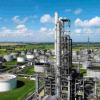here is a problem i'm facing.
1) heat exchanger is vertical cross flow combined type heat exchanger. 1-1 type exchanger .
2) shell side : inlet from top and bottom , outlet from mid section
Tube side : inlet from bottom outlet from top
3) shell side stream : Ethylene glycol water inlet 40 deg C 10 barg , outlet 5 deg C , Ethylene glycol is operating in closed circuit and it gains heat from other source after heat exchanger and comes back to heat exchanger again to inlet.
Tube side stream : liquid ethane -170 deg C P = 150 barg , outlet gaseous ethane 0 deg C
Problem facing : Ethylene glycol circuit flow is around 4000 m3/hr and its flow fluctuates sometimes to 2000 m3/hr very often including its top and bottom flow , leading to triggering the low low flow alarm . we are having trip interlock for heat exchanger on low low flow alarm which leads to trip the heat exchanger very often.
so after doing some troubleshooting we start venting in ehtylene glycol water line and results in some gas is coming from vent valve . after doing LEL test it show gas is having some hydrocarbon composition. but the pressure in Ethylene glycol water line remains same 10 barg.

 FB
FB










